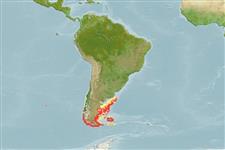Common names from other countries
Classification / Names / Names
Populaire namen | Synoniemen | Catalog of Fishes (gen., sp.) | ITIS | CoL | WoRMS
Environment: milieu / climate zone / depth range / distribution range
Ecologie
; diepteverspreiding 0 - 90 m (Ref. 83435). Temperate; 38°S - 56°S, 74°E - 57°E (Ref. 83435)
Southeast Pacific and Southwest Atlantic: Chile, Falkland and Argentina.
Length at first maturity / Size / Gewicht / Leeftijd
Maturity: Lm ? range ? - ? cm Max length : 2.4 cm DL mannelijk/geslacht niet bekend; (Ref. 83435)
It is found on rocky substrates, on or beneath rocks, in rock crevices, rocky walls and tide pools, and on brown algae (Ref. 87801), like forests of Macrocystis pyrifera (Ref. 92889).
Life cycle and mating behavior
Geslachtsrijpheid | Voortplanting | Kuitschieten | Eieren | Fecundity | Larven
Egg masses are composed of 4 to 19 egg capsules, containing 1 to 5 embryos developing within each capsule and emerges as crawling juveniles. Egg capsules are attached to a substrate.
Rosenberg, G. 2009. (Ref. 83435)
Status op de Rode Lijst van het IUCN (Ref. 130435)
Status bij CITES (Ref. 108899)
Not Evaluated
Not Evaluated
Gebruik door de mens
| FishSource |
Tools
Meer informatie
Populaire namenSynoniemenPredatorsVoortplantingGeslachtsrijpheidKuitschietenFecundityEierenOntwikkeling van de eieren
Leeftijd/Grootte
Groei
Lengte-gewicht parameters
Lengte-lengte parameters
Morfologie
Larven
Abundantie
Internet-bronnen
Estimates based on models
Preferred temperature
(Ref.
115969): 6.3 - 13.1, mean 8.6 (based on 194 cells).
Prijsklasse
Unknown.
